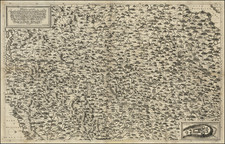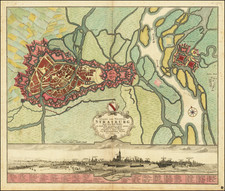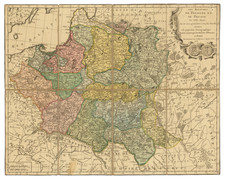From the Collection of General Nicolas Oudinot
Detailed map of the Erfurt region, published in Augsburg by Gussefeld.
This is perhaps the earliest printed map of Erfurt, following its becoming a part of the Kingdom of Prussia.
Erfurt became part of the Kingdom of Prussia in 1802, to compensate for territories Prussia lost to France on the Left Bank of the Rhine.
On October 16, 1806, as a result of the Capitulation of Erfur,t the city, its 12,000 Prussian and Saxon defenders under William VI, Prince of Orange-Nassau, 65 artillery pieces, and the Petersberg and Cyriaksburg fortresses (Zitadellen von Petersberg und Cyriaksburg) were handed over to the French.
At the time of the capitulation, Joachim Murat, Marshal of France, had about 16,000 troops near Erfurt. With the attachment of the Saxe-Weimar territory of Blankenhain, the city became part of the First French Empire in 1806 as the Principality of Erfurt, directly subordinate to Napoleon as an "imperial state domain", separate from the Confederation of the Rhine, which the surrounding Thuringianstates had joined. Erfurt was administered by a civilian and military Senate (Finanz- und Domänenkammer Erfurt) under a French governor, based in the Kurmainzische Statthalterei, previously the seat of city's governor under the Electorate.
Napoleon first visited the principality on July 23, 1807, inspecting the citadels and fortifications. In 1808, the Congress of Erfurt was held with Napoleon and Alexander I of Russia visiting the city.
General Nicolas Charles Oudinot
A final detail that gives this map particular importance is the identity of its former owner, Nicolas Charles Oudinot, 1st Comte Oudinot, 1st Duc de Reggio (1767 - 1848), and a Marshal of France. A fierce fighter, the man was wounded no less than 34 times during his military career!
The only one of nine siblings to live past childhood, Oudinot joined the army without a noble pedigree, and therefore without a chance of high promotion. That all changed in 1792, with the outbreak of the French Revolution. In that year, Oudinot was elected lieutenant-colonel of the third battalion of the volunteers of the Meuse. After transfer to the regular army and admirable service in Belgium, he was promoted to the rank of general in June 1794 after the Battle of Kaiserslautern.
From Belgium he shifted to the German and Swiss fronts, where he fought as a general of division and chief of staff to Andre Massena. Oudinot stood out at the Battle of Monzambano so much so that Napoleon himself presented him with a sword of honor, now known as the Legion d'Honneur. Napoleon did not forget him after he established his empire; now Emperor Napoleon recognized Oudinot again, this time with a Grand Cross of the Legion of Honor.
During the Napoleonic Wars, Oudinot continued to acquit himself commendably. He was elected a member of the Chamber of Deputies, commanded a company of grenadiers nicknamed for him, and fought in battles from Vienna to Poland. In 1808, he was appointed governor of Erfurt and was made a Count of the French Empire. Finally, in 1809, after the Battle of Wagram, he was named a Marshal of France, France's highest military distinction.
Oudinot continued to serve as an administrator in Holland and on the battlefield in the Russian campaign. After Napoleon's fall, Oudinot joined the Bourbon Restoration and stayed loyal to the King even after Napoleon's return in 1815. For his loyalty and service, he was named a peer of the realm. He served until 1823, when he participated in the French invasion of Spain. Then, he turned again to political and administrative appointments; he died while serving as governor of Les Invalides, at the veterans' hospital in Paris.
Provenance
Purchased at auction in Paris, from Artcuriel, Collections from the Castle of Malicorne Marshal Oudinot's Historical Souvenirs, June 13, 2017 (Lot 156).









![(Second World War - Prelude to War) Die Luftbedrohung Deutschlands [The Air Threat to Germany]](https://storage.googleapis.com/raremaps/img/small/84075.jpg)


![[ German Postal Routes ] Nouvelle Carte Geographique des Postes D'Allemagne et des Provinces limitrophes . . . / Neue und vollstaendige Postkare durch Ganz Deutschland . . . 1786](https://storage.googleapis.com/raremaps/img/small/99352.jpg)

![[First Postwar Elections In West Germany] Elections Au Bundestage du 14 Aout 1949](https://storage.googleapis.com/raremaps/img/small/78827.jpg)